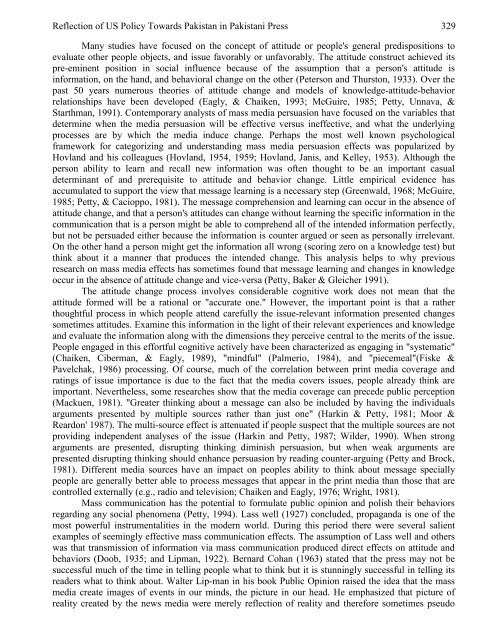European Journal of Scientific Research - EuroJournals
European Journal of Scientific Research - EuroJournals
European Journal of Scientific Research - EuroJournals
You also want an ePaper? Increase the reach of your titles
YUMPU automatically turns print PDFs into web optimized ePapers that Google loves.
Reflection <strong>of</strong> US Policy Towards Pakistan in Pakistani Press 329<br />
Many studies have focused on the concept <strong>of</strong> attitude or people's general predispositions to<br />
evaluate other people objects, and issue favorably or unfavorably. The attitude construct achieved its<br />
pre-eminent position in social influence because <strong>of</strong> the assumption that a person's attitude is<br />
information, on the hand, and behavioral change on the other (Peterson and Thurston, 1933). Over the<br />
past 50 years numerous theories <strong>of</strong> attitude change and models <strong>of</strong> knowledge-attitude-behavior<br />
relationships have been developed (Eagly, & Chaiken, 1993; McGuire, 1985; Petty, Unnava, &<br />
Starthman, 1991). Contemporary analysts <strong>of</strong> mass media persuasion have focused on the variables that<br />
determine when the media persuasion will be effective versus ineffective, and what the underlying<br />
processes are by which the media induce change. Perhaps the most well known psychological<br />
framework for categorizing and understanding mass media persuasion effects was popularized by<br />
Hovland and his colleagues (Hovland, 1954, 1959; Hovland, Janis, and Kelley, 1953). Although the<br />
person ability to learn and recall new information was <strong>of</strong>ten thought to be an important casual<br />
determinant <strong>of</strong> and prerequisite to attitude and behavior change. Little empirical evidence has<br />
accumulated to support the view that message learning is a necessary step (Greenwald, 1968; McGuire,<br />
1985; Petty, & Cacioppo, 1981). The message comprehension and learning can occur in the absence <strong>of</strong><br />
attitude change, and that a person's attitudes can change without learning the specific information in the<br />
communication that is a person might be able to comprehend all <strong>of</strong> the intended information perfectly,<br />
but not be persuaded either because the information is counter argued or seen as personally irrelevant.<br />
On the other hand a person might get the information all wrong (scoring zero on a knowledge test) but<br />
think about it a manner that produces the intended change. This analysis helps to why previous<br />
research on mass media effects has sometimes found that message learning and changes in knowledge<br />
occur in the absence <strong>of</strong> attitude change and vice-versa (Petty, Baker & Gleicher 1991).<br />
The attitude change process involves considerable cognitive work does not mean that the<br />
attitude formed will be a rational or "accurate one." However, the important point is that a rather<br />
thoughtful process in which people attend carefully the issue-relevant information presented changes<br />
sometimes attitudes. Examine this information in the light <strong>of</strong> their relevant experiences and knowledge<br />
and evaluate the information along with the dimensions they perceive central to the merits <strong>of</strong> the issue.<br />
People engaged in this effortful cognitive actively have been characterized as engaging in "systematic"<br />
(Chaiken, Ciberman, & Eagly, 1989), "mindful" (Palmerio, 1984), and "piecemeal"(Fiske &<br />
Pavelchak, 1986) processing. Of course, much <strong>of</strong> the correlation between print media coverage and<br />
ratings <strong>of</strong> issue importance is due to the fact that the media covers issues, people already think are<br />
important. Nevertheless, some researches show that the media coverage can precede public perception<br />
(Mackuen, 1981). "Greater thinking about a message can also be included by having the individuals<br />
arguments presented by multiple sources rather than just one" (Harkin & Petty, 1981; Moor &<br />
Reardon' 1987). The multi-source effect is attenuated if people suspect that the multiple sources are not<br />
providing independent analyses <strong>of</strong> the issue (Harkin and Petty, 1987; Wilder, 1990). When strong<br />
arguments are presented, disrupting thinking diminish persuasion, but when weak arguments are<br />
presented disrupting thinking should enhance persuasion by reading counter-arguing (Petty and Brock,<br />
1981). Different media sources have an impact on peoples ability to think about message specially<br />
people are generally better able to process messages that appear in the print media than those that are<br />
controlled externally (e.g., radio and television; Chaiken and Eagly, 1976; Wright, 1981).<br />
Mass communication has the potential to formulate public opinion and polish their behaviors<br />
regarding any social phenomena (Petty, 1994). Lass well (1927) concluded, propaganda is one <strong>of</strong> the<br />
most powerful instrumentalities in the modern world. During this period there were several salient<br />
examples <strong>of</strong> seemingly effective mass communication effects. The assumption <strong>of</strong> Lass well and others<br />
was that transmission <strong>of</strong> information via mass communication produced direct effects on attitude and<br />
behaviors (Doob, 1935; and Lipman, 1922). Bernard Cohan (1963) stated that the press may not be<br />
successful much <strong>of</strong> the time in telling people what to think but it is stunningly successful in telling its<br />
readers what to think about. Walter Lip-man in his book Public Opinion raised the idea that the mass<br />
media create images <strong>of</strong> events in our minds, the picture in our head. He emphasized that picture <strong>of</strong><br />
reality created by the news media were merely reflection <strong>of</strong> reality and therefore sometimes pseudo

















